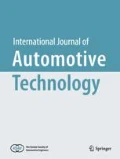Abstract
Light electric vehicles (LEVs) are usually used as neighborhood electric vehicles (NEVs) for the second vehicle or car-sharing service. For LEVs, it is important to reduce energy consumption to have greater mileage at the same battery capacity. One of the direct ways to decrease energy consumption is the efficiency improvement of the traction motor, which is the main propulsion system. Also, the weight reduction of the traction motor can be a solution to energy usage mitigation. This paper suggested the design process of a traction motor for LEV considering material properties to minimizing the energy consumption of the vehicle. During the design process, vehicle simulation was adopted to calculate energy consumption. In addition, traction motor and battery which are the key components of LEV were mathematically modeled and used in the simulation. Using them, energy consumption was estimated within the change of stack length of the traction motor for some drive cycles. Finally, from these simulations, optimum power density is determined which minimizes energy consumption.
Similar content being viewed by others
References
Bianchi, N. and Jahns, T. M. (2004). Design, analysis, and control of interior PM synchronous machines. Tutorial course notes, IEEE Industry applications society, Seattle, Washington, USA.
Grunditz, E. A. and Thiringer, T. (2016). Performance analysis of current BEVs based on a comprehensive review of specifications. IEEE Trans. Transportation Electrification 2, 3, 270–289.
Heydari, S., Fajri, P., Rasheduzzaman, M. and Sabzehgar, R. (2019). Maximizing regenerative braking energy recovery of electric vehicles through dynamic low-speed cutoff point detection. IEEE Trans. Transportation Electrification 5, 1, 262–270.
Hu, Y., Yurkovich, S., Guezennec, Y. and Yurkovich, B. (2011). Electro-thermal battery model identification for automotive applications. J. Power Sources 196, 1, 449–457.
Huang, J., Liu, Y. Liu, M. Cao, M. and Yan, Q. (2019). Multi-objective optimization control of distributed electric drive vehicles based on optimal torque distribution. IEEE Access, 7, 16377–16394.
Hwang, S.-W., Sim, J.-H. Hong, J.-P. and Lee, J.-Y. (2018). Torque improvement of wound field synchronous motor for electric vehicle by PM-Assist. IEEE Trans. Industry Applications 54, 4, 3252–3259.
Jafari, M., Gauchia, A., Zhao, S., Zhang, K. and Gauchia, L. (2018). Electric vehicle battery cycle aging evaluation in real-world daily driving and vehicle-to-grid services. IEEE Trans. Transportation Electrification 4, 1, 122–134.
Jung, Y.-H., Kim, K.-O. and Hong, J.-P. (2019). Design of multi-layer IPMSM using ferrite PM considering mechanical and electrical characteristics. 2019 IEEE Energy Conversion Cong. and Expo. (ECCE), Baltimore, MD, USA, 3534–3541.
Kalathil, D., Wu, C., Poolla, K. and Varaiya, P. (2019). The sharing economy for the electricity storage. IEEE Trans. Smart Grid 10, 1, 556–567.
Kim, D.-M., Chin, J.-W., Hong, J.-P. and Lim, M.-S. (2019a). Performance prediction of surface-mounted permanent magnet synchronous motor based on ring specimen test result. IET Electric Power Applications 13, 9, 1280–1286.
Kim, D.-M., Benoliel, P., Kim, D.-K., Lee T. H., Park, J. W. and Hong, J.-P. (2019b). Framework development of series hybrid powertrain design for heavy-duty vehicle considering driving conditions. IEEE Trans. Vehicular Technology 68, 7, 6468–6480.
Klein III, M. P. and Park, J. W. (2017). Effects of nonuniform temperature on in-situ current distribution and non-uniform state of charge measurements for LiFePO4 and LiNiMnCoO2 cells. ECS Trans. 77, 11, 81–97.
Lee, B.-H., Hong, J.-P. and Lee, J.-H. (2012). Optimum design criteria for maximum torque and efficiency of a line-start permanent-magnet motor using response surface methodology and finite element method. IEEE Trans. Magnetics 48, 2, 863–866.
Liu, C., Chai, K. K., Zhang, X., Lau, E. T. and Chen, Y. (2018). Adaptive blockchain-based electric vehicle participation scheme in smart grid platform. IEEE Access, 6, 25657–25665.
Matsui, N., Takeda, Y., Morimoto, S. and Honda, Y. (2001). Design, and Control of IPMSM. Ohmsha, Ltd.
Momen, F., Rahman, K. and Son, Y. (2019). Electrical propulsion system design of Chevrolet bolt battery electric vehicle. IEEE Trans. Industry Applications 55, 1, 376–384.
Park, M.-R., Kim, H.-J., Choi, Y.-Y., Hong, J.-P. and Lee, J.-J. (2016). Characteristics of IPMSM According to Rotor Design Considering Nonlinearity of Permanent Magnet. IEEE Trans. Magnetics 52, 3, 1–4.
Rahman, K. and Hiti, S. (2017). Trends in EV propulsion components and systems [about this issue]. IEEE Electrification Magazine 5, 1, 2–3.
Search Term: Electric Vehicle (2019). Web of Science. http://www.webofknowlegde.com.
Wu, J., Wang, J., Gan, C., Sun, Q. and Kong, W. (2018). Efficiency optimization of PMSM drives using field-circuit coupled FEM for EV/HEV applications. IEEE Access 6, 15192–15201.
Xiang, Z., Zhu, X., Quan, L. and Chen, Y. (2019). Design and analysis of double-air-gap flux-modulated permanent magnet motor considering leading working harmonics. IEEE Trans. Magnetics 55, 6, 1–5.
Xiong, R., Cao, J., Yu, Q., He, H. and Sun, F. (2017). Critical review on the battery state of charge estimation methods for electric vehicles. IEEE Access, 6, 1832–1843.
Zhao, J., Fu, W., Zheng, Y, Chen, Z. and Wang, Y. (2019). Comparative study of modular-stator and conventional outer-rotor flux-switching permanent-magnet motors. IEEE Access, 7, 38297–38305.
Acknowledgement
This work was supported by the National Research Foundation of Korea (NRF) grant funded by the Korea government (MSIP; Ministry of Science, ICT & Future Planning) (No. NRF-2020R1A4A4079701).
Author information
Authors and Affiliations
Corresponding author
Additional information
Publisher’s Note
Springer Nature remains neutral with regard to jurisdictional claims in published maps and institutional affiliations.
Rights and permissions
About this article
Cite this article
Kim, DM., Jung, YH., Cha, KS. et al. Design of Traction Motor for Mitigating Energy Consumption of Light Electric Vehicle Considering Material Properties and Drive Cycles. Int.J Automot. Technol. 21, 1391–1399 (2020). https://doi.org/10.1007/s12239-020-0131-7
Received:
Revised:
Accepted:
Published:
Issue Date:
DOI: https://doi.org/10.1007/s12239-020-0131-7




